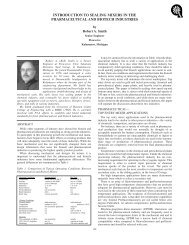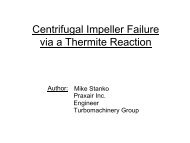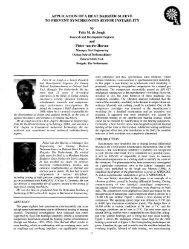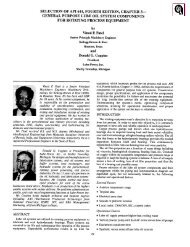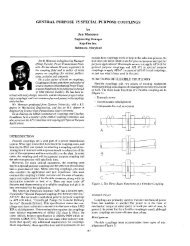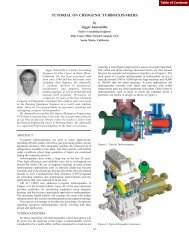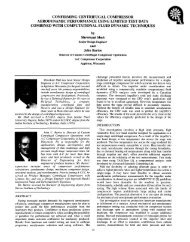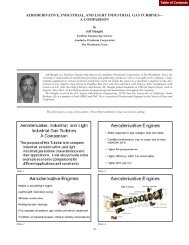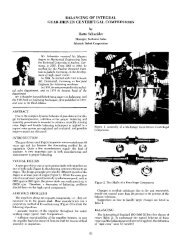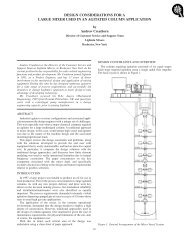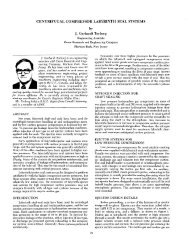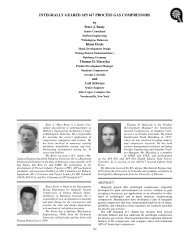ISO 13709 2nd Edition/ API 610 Eleventh Edition Highlights
ISO 13709 2nd Edition/ API 610 Eleventh Edition Highlights
ISO 13709 2nd Edition/ API 610 Eleventh Edition Highlights
Create successful ePaper yourself
Turn your PDF publications into a flip-book with our unique Google optimized e-Paper software.
53<br />
The following two Figures K.2 (SI units) and K.3 (USC units)<br />
show the relationship of pump “sizing” factor K t to SFI. K t is<br />
derived from the formula K t = (Q x H)/ N where Q is the flow<br />
at best efficiency point (BEP) of the maximum impeller<br />
diameter; H is the corresponding total head at the BEP; and N<br />
is the rotating speed. The legend A through G represents<br />
different vintages of overhung pumps manufactured over the<br />
years.<br />
right end of the chart. This high-side area was derived by<br />
equations:<br />
(K.4) I SF, SI = 32 x K t<br />
– 0.76<br />
(K.5) I SF, USC = 6200 x K t<br />
– 0.76<br />
The criteria stated in <strong>Eleventh</strong> <strong>Edition</strong> are:<br />
“ Figures K.2 and K.3 or Equations (K.4) and (K.5) can be used<br />
to make a first assessment of the rotor stiffness of a given<br />
overhung pump design or a number of similar designs for a<br />
given application. An overhung pump whose I SF is more than<br />
1.2 times the chart or equation value is cause to seek<br />
justification of the design from the pump vendor”.<br />
The WGTF did evaluate a more complicated approach which<br />
included the diameter of the shaft between the bearings, but in<br />
the end it was decided to go with the SFI method. This was a<br />
more scientific way of approaching the subject than the one<br />
originally proposed using 100 (USC units) across the board for<br />
all pump sizes.<br />
It should be noted that <strong>ISO</strong> <strong>13709</strong>/ <strong>API</strong> <strong>610</strong> contains various<br />
requirements that affect pump shaft size and stiffness. These<br />
requirements include the following: a) shaft deflection at the<br />
seal faces is limited to 0.05mm (0.002 in) under the worst<br />
conditions, b) one and two stage pumps are required to have a<br />
dry bending first critical above 120% of maximum continuous<br />
speed, c) seal chambers are standardized, d) bearings must be<br />
designed for a minimum life of 25,000 hrs and e) comply with<br />
the <strong>ISO</strong> <strong>13709</strong>/ <strong>API</strong> <strong>610</strong> vibration criteria.<br />
These requirements except for seal chamber dimensions<br />
collectively drive down the SFI values to a stiffer shaft design<br />
while the seal chamber dimensions set the minimum overhang<br />
the pump can have and limit how low to push the SFI value.<br />
The following data from a pump company exemplifies the<br />
improvement in MTBR after old original pump designs with<br />
skinny shafts and high SFI values were upgraded to today’s<br />
more robust overhung rotor designs with low SFI values.<br />
For clarity, units of measure are:<br />
Parameter<br />
Units of Measure<br />
SI<br />
USC<br />
D - diameter mm in<br />
L - length mm in<br />
Q - flow rate m 3 /h gpm<br />
H - total head m ft<br />
N - rotative speed r/min rpm<br />
Basically, small pump sizes with typically single volute casings<br />
are represented in the left area of the chart, while medium size<br />
dual volute pumps are towards the middle and large pump sizes<br />
(large pump-turbines) up to 350000kW ( 500000 hp) are at the<br />
The improvement in MTBR is the bottom line result when<br />
providing pump designs with low SFI values. This whole<br />
subject of SFI is intended to bring attention to its importance<br />
and to serve as a differentiator in evaluating pumps that are not<br />
in line with the most current designs. Some of the very old<br />
overhung rotor designs had SFI of 300 or even over 1000,<br />
which represent very skinny shaft designs. A pump having a<br />
SFI of 100 vs. another having SFI of 50 is really not the issue.<br />
It is when there is a quantum difference in SFI values that<br />
raises the concern and the need to have a discussion with a



